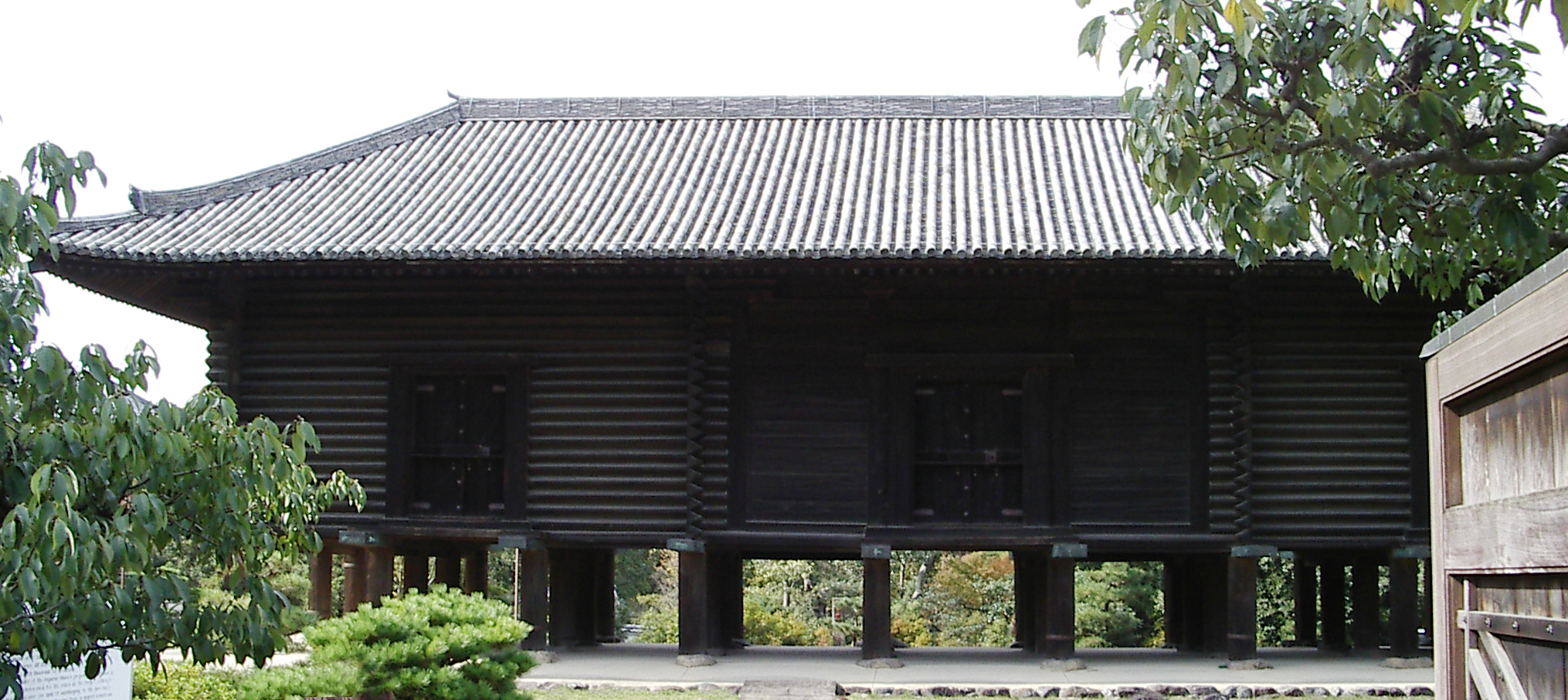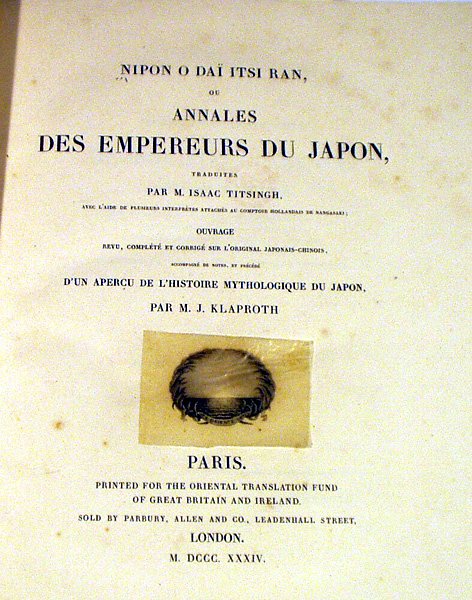|
┼ītoku
was a after '' Eih┼Ź'' and before ''Kanji''. This period spanned the years from February 1084 through April 1087. The reigning emperor was . Change of Era * February 9, 1084 : The new era name was created to mark an event or series of events. The previous era ended and the new one commenced in ''Eih┼Ź'' 4, on the 7th day of the 2nd month.Brown, p. 316. Events of the ''┼ītoku'' Era * 1084 (''┼ītoku 1, 9th month''): The empress Kenshi, the emperor's principal consort, died. Shirakawa was afflicted with great grief, and for a time, he turned over the administration of the government to his ministers.Titsingh p. 171./ref> * 1086 (''┼ītoku 3, 9th month''): Shirakawa announced his intention to abdicate in favor of his son. * January 3, 1087 (''┼ītoku 3, 26th day of the 11th month''): Shirakawa formally abdicated, and he took the title '' Daij┼Ź-tenn┼Ź.'' Shirakawa had personally occupied the throne for 14 years; and for the next 43 years, he would exercise broad powers in what will ... [...More Info...] [...Related Items...] OR: [Wikipedia] [Google] [Baidu] |
Emperor Shirakawa
was the 72nd emperor of Japan,Imperial Household Agency (''Kunaich┼Ź'') ńÖĮµ▓│Õż®ńÜć (72)/ref> according to the traditional order of succession. Shirakawa's reign lasted from 1073 to 1087. Genealogy Before his ascension to the Chrysanthemum Throne, his personal name (''imina'') was Sadahito''-shinn┼Ź'' (Ķ▓×õ╗üĶ”¬ńÄŗ). He was the eldest son of Emperor Go-Sanj┼Ź and Fujiwara Shigeko (ĶŚżÕĤĶīéÕŁÉ). Shirakawa had one Empress and one Imperial Consort and nine Imperial sons and daughters. *Empress (ch┼½g┼½): Fujiwara no Kenshi (ĶŚżÕĤĶ│óÕŁÉ)ŌĆöMinamoto AkifusaŌĆśs daughter, adopted by Fujiwara Morozane ** First Son: Imperial Prince Atsufumi (µĢ”µ¢ćĶ”¬ńÄŗ; 1075ŌĆō1077) ** First Daughter: Imperial Princess Yasuko (Õ¬×ÕŁÉÕåģĶ”¬ńÄŗ) later IkuhomonŌĆÖin (ķāüĶŖ│ķ¢ĆķÖó) ** Third Daughter: Imperial Princess Reishi (õ╗żÕŁÉÕåģĶ”¬ńÄŗ) ''saig┼½'' ** Third Son: Imperial Prince Taruhito (Õ¢äõ╗üĶ”¬ńÄŗ) later Emperor Horikawa ** Fourth Daughter: Imperial Princess Shinshi (ń”øÕŁÉÕåģĶ”¬ńÄŗ; 10 ... [...More Info...] [...Related Items...] OR: [Wikipedia] [Google] [Baidu] |
Kanji (era)
was a after ''┼ītoku'' and before ''Kah┼Ź''. This period spanned the years from April 1087 through December 1094. The reigning emperor was Emperor Horikawa (ÕĀƵ▓│Õż®ńÜć). Change of era * February 6, 1087 : The new era name was created to mark an event or series of events. The previous era ended and the new one commenced in ''┼ītoku'' 4, on the 7th day of the 4th month of 1087. Events of the ''Kanji'' era * 1087 (''Kanji 1, 5th month''): '' Daij┼Ź-tenn┼Ź'' Shirakawa retired himself to Uji.Titsingh p. 172./ref> * 1088 (''Kanji 2, 1st month''): The emperor paid a visit to his father's home.Titsingh p. 173./ref> * 1088 (''Kanji 2, 10th month''): Shirakawa visited the temples at Mt. Hiei. * January 28, 1088 (''Kanji 2, 14th day of the 12th month''): The ''sessh┼Ź'' Fujiwara Morozane was given additional honors with the further title of ''daij┼Ź-daijin''. In this context, it matters a great deal that the mother of Emperor Horikowa, formerly the daughter of ''udaijin'' Minamoto no ... [...More Info...] [...Related Items...] OR: [Wikipedia] [Google] [Baidu] |
Eih┼Ź
was a after '' J┼Źryaku'' and before '' ┼ītoku.'' This period spanned the years from February 1081 through April 1084. The reigning emperor was . Change of Era * February 12, 1081 : The new era name was created to mark an event or series of events. The previous era ended and the new one commenced in ''J┼Źryaku'' 5, on the 10th day of the 2nd month of 1081.Brown, p. 316. Events of the ''Eih┼Ź'' Era * May 26, 1081 (''Eih┼Ź 1, 15th day of the 4th month''): The Buddhist Temple of Miidera was set on fire by the monks of a rival sect on Mount Hiei. * July 12, 1081 (''Eih┼Ź 1, 4th day of the 6th month''): Miidera was burned again by monks from Mt. Hiei. * 1083 (''Eih┼Ź 3, 10th month''): At Hossh┼Ź-ji, construction begins on a nine-story pagoda.Titsingh p. 171./ref> Notes References * Brown, Delmer M. and Ichir┼Ź Ishida, eds. (1979) ''Gukansh┼Ź: The Future and the Past.''Berkeley: University of California Press. OCLC 251325323* Nussbaum, Louis-Fr├®d├®ric and K├żthe Roth. (2005) ... [...More Info...] [...Related Items...] OR: [Wikipedia] [Google] [Baidu] |
Japanese Era Name
The or , is the first of the two elements that identify years in the Japanese era calendar scheme. The second element is a number which indicates the year number within the era (with the first year being "", meaning "origin, basis"), followed by the literal "" meaning "year". Chinese era name, Era names originated in 140 BCE in Imperial China, during the reign of the Emperor Wu of Han. As elsewhere in the Sinosphere, the use of era names was originally derived from Chinese imperial practice, although the Japanese system is independent of the Chinese, Korean era name, Korean, and Vietnamese era name, Vietnamese era name systems. Unlike its other Sinosphere counterparts, Japanese era names are still in official use. Government offices usually require era names and years for official papers. The five era names used since the end of the Edo period in 1868 can be abbreviated by taking the first letter of their Hepburn romanization, romanized names. For example, S55 means Sh┼Źwa 55 ( ... [...More Info...] [...Related Items...] OR: [Wikipedia] [Google] [Baidu] |
Sh┼Źs┼Źin
The is the wikt:treasure house, treasure house of T┼Źdai-ji Temple in Nara, Nara, Nara, Japan. The building is in the ''azekura'' (log-cabin) style with a raised floor. It lies to the northwest of the Great Buddha Hall. The Sh┼Źs┼Ź-in houses artifacts connected to Emperor Sh┼Źmu (Ķü¢µŁ”Õż®ńÜć)(701ŌĆō756) and Empress K┼Źmy┼Ź (ÕģēµśÄńÜćÕÉÄ)(701ŌĆō760), as well as arts and crafts of the Tenpy┼Ź, Tempy┼Ź (Õż®Õ╣│) era of History of Japan, Japanese history. History The construction of the T┼Źdai-ji Buddhist temple complex was ordained by Emperor Sh┼Źmu as part of a national project of Buddhist temple construction. During the Tenpy┼Ź, Tempy┼Ź period, the years during which Emperor Sh┼Źmu reigned, multiple disasters struck Japan as well as political uproar and epidemics. Because of these reasons Emperor Sh┼Źmu launched a project of provincial temples. The T┼Źdai-ji was appointed as the head temple of these provincial temples. Emperor Sh┼Źmu was a strong supporter of Buddhism and he tho ... [...More Info...] [...Related Items...] OR: [Wikipedia] [Google] [Baidu] |
Fujiwara No Kenshi (1057ŌĆō1084)
Fujiwara no Kenshi (1057ŌĆō1084) was the empress consort of Emperor Shirakawa of Japan. Biography She was a daughter of Minamoto Akifusa (''µ║ÉķĪĢµł┐''), and adopted by Fujiwara no Morozane (ĶŚżÕĤÕĖ½Õ«¤). ;Issue: *Imperial Prince Atsufumi (µĢ”µ¢ćĶ”¬ńÄŗ; 1075ŌĆō1077) *Imperial Princess Yasuko (Õ¬×ÕŁÉÕåģĶ”¬ńÄŗ) later IkuhomonŌĆÖin (ķāüĶŖ│ķ¢ĆķÖó) *Imperial Princess Reishi (õ╗żÕŁÉÕåģĶ”¬ńÄŗ) ''saig┼½'' *Imperial Prince Taruhito (Õ¢äõ╗üĶ”¬ńÄŗ) later Emperor Horikawa was the 73rd emperor of Japan,Imperial Household Agency (''Kunaich┼Ź'') ÕĀƵ▓│Õż®ńÜć (73)/ref> according to the traditional List of emperors of Japan, order of succession. Horikawa's reign spanned the years from Heian period, 1087 through 1107 ... *Imperial Princess Shinshi (ń”øÕŁÉÕåģĶ”¬ńÄŗ; 1081ŌĆō1156)ŌĆöTsuchimikado Saiin (Õ£¤ÕŠĪķ¢Ćµ¢ÄķÖó) Notes {{DEFAULTSORT:Fujiwara, Kenshi 1057 births 1084 deaths 11th-century Japanese people 11th-century Japanese women Fujiwara clan Japanese empresses con ... [...More Info...] [...Related Items...] OR: [Wikipedia] [Google] [Baidu] |
Cloistered Rule
was a form of government in Japan during the Heian period. In this bifurcated system, an emperor abdicated, but retained power and influence. Those retired emperors who withdrew to live in monasteries (''in'') continued to act in ways intended to counterbalance the influence of Fujiwara regents and the warrior class.Nussbaum, Louis-Fr├®d├®ric. (2005). "''Insei''" in Simultaneously, the titular emperor, the former emperor's chosen successor, fulfilled all the ceremonial roles and formal duties of the monarchy. Retired emperors were called '' Daij┼Ź Tenn┼Ź'' or ''J┼Źk┼Ź''. A retired emperor who entered a Buddhist monastic community became a Cloistered Emperor (''Japanese'' Õż¬õĖŖµ│ĢńÜć Daij┼Ź H┼Ź┼Ź). There were retired emperors, including cloistered emperors, both before and after the Heian period, but the notion of cloistered rule as a system usually refers to the practice put in place by Emperor Shirakawa in 1086 and followed by his successors until the rise of the Kamakura ... [...More Info...] [...Related Items...] OR: [Wikipedia] [Google] [Baidu] |
Harvard University Press
Harvard University Press (HUP) is an academic publishing house established on January 13, 1913, as a division of Harvard University. It is a member of the Association of University Presses. Its director since 2017 is George Andreou. The press maintains offices in Cambridge, Massachusetts, near Harvard Square, and in London, England. The press co-founded the distributor TriLiteral LLC with MIT Press and Yale University Press. TriLiteral was sold to LSC Communications in 2018. Notable authors published by HUP include Eudora Welty, Walter Benjamin, E. O. Wilson, John Rawls, Emily Dickinson, Stephen Jay Gould, Helen Vendler, Carol Gilligan, Amartya Sen, David Blight, Martha Nussbaum, and Thomas Piketty. The Display Room in Harvard Square, dedicated to selling HUP publications, closed on June 17, 2009. Related publishers, imprints, and series HUP owns the Belknap Press imprint (trade name), imprint, which it inaugurated in May 1954 with the publication of the ''Harvard Guide to ... [...More Info...] [...Related Items...] OR: [Wikipedia] [Google] [Baidu] |
Isaac Titsingh
Isaac Titsingh FRS ( January 1745 ŌĆō 2 February 1812) was a Dutch diplomat, historian, Japanologist, and merchant.Nussbaum, Louis-Fr├®d├®ric. (2005). "Isaak Titsingh" in . During a long career in East Asia, Titsingh was a senior official of the Dutch East India Company (). He represented the European trading company in exclusive official contact with Tokugawa Japan, traveling to Edo twice for audiences with the shogun and other high bakufu officials. He was the Dutch and VOC governor general in Chinsura, Bengal.Stephen R. Platt, ''Imperial Twilight: the Opium War and the End of China's Last Golden Age'' (NY: Knopf, 2018), 166-73. Titsingh worked with his counterpart, Charles Cornwallis, who was governor general of the British East India Company. In 1795, Titsingh represented Dutch and VOC interests in China, where his reception at the court of the Qing Qianlong Emperor stood in contrast to the rebuff suffered by British diplomat George Macartney's mission in 1793, just ... [...More Info...] [...Related Items...] OR: [Wikipedia] [Google] [Baidu] |
Nihon ┼īdai Ichiran
, ', is a 17th-century chronicle of the serial reigns of Japanese emperors with brief notes about some of the noteworthy events or other happenings. According to the 1871 edition of the ''American Cyclopaedia'', the 1834 French translation of ''Nihon ┼īdai Ichiran'' was one of very few books about Japan available in the Western world. Prepared under the patronage of the ''tair┼Ź'' Sakai Tadakatsu The material selected for inclusion in the narrative reflects the perspective of its original Japanese author and his samurai patron, the ''tair┼Ź'' Sakai Tadakatsu, who was ''daimy┼Ź'' of the Obama Domain of Wakasa Province. It was the first book of its type to be brought from Japan to Europe, and was translated into French as "''Nipon o da├» itsi ran''". Dutch Orientalist and scholar Isaac Titsingh brought the seven volumes of ''Nihon ┼īdai Ichiran'' with him when he returned to Europe in 1797 after twenty years in the Far East. All these books were lost in the turmoil of the N ... [...More Info...] [...Related Items...] OR: [Wikipedia] [Google] [Baidu] |



